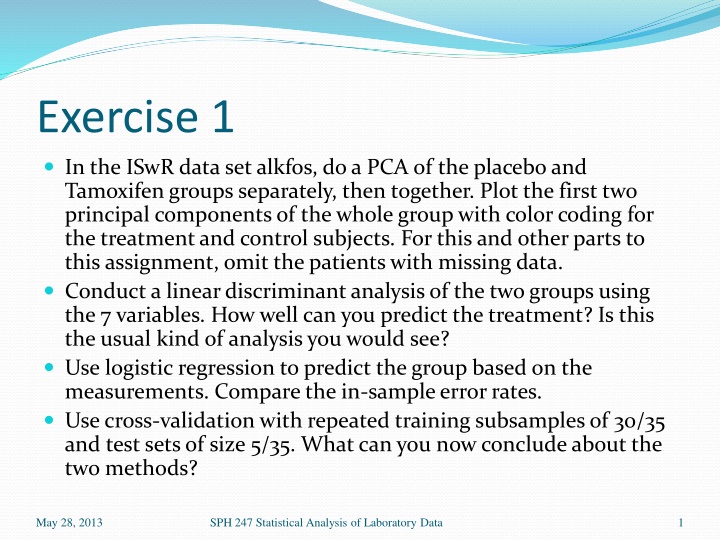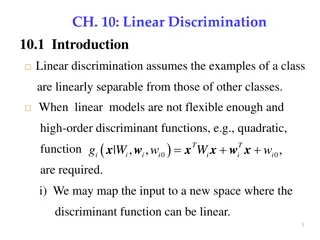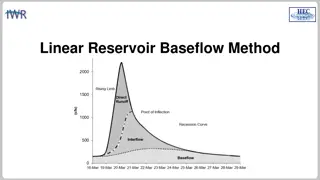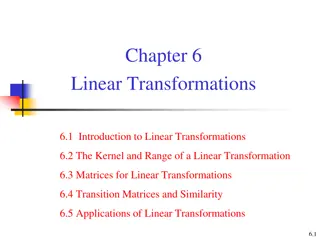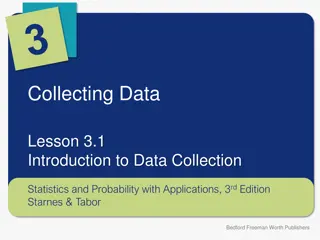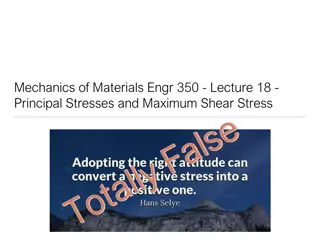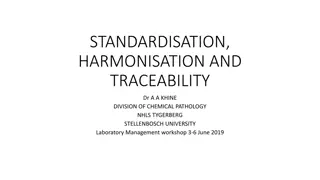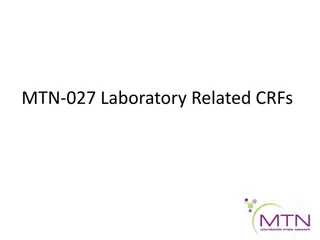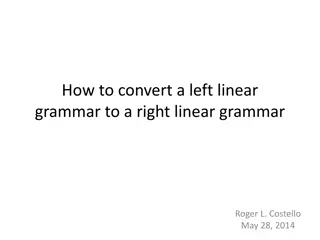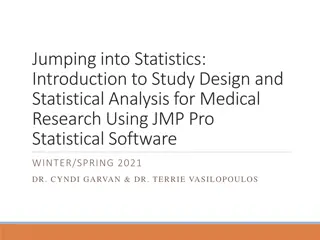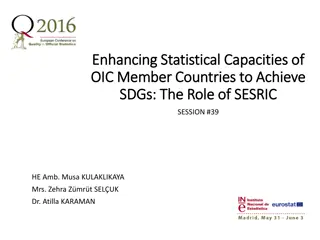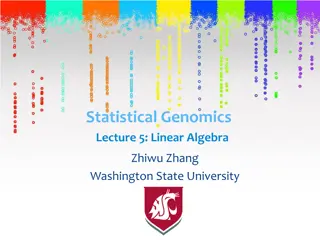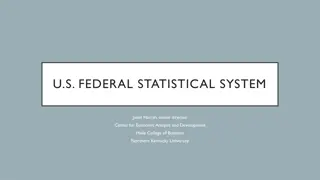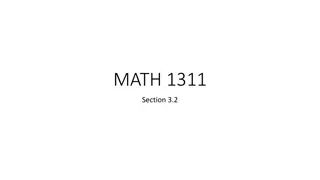Statistical Analysis of Laboratory Data: Principal Component Analysis and Linear Discriminant Analysis
Conducting a comprehensive statistical analysis on the ISwR dataset "alkfos," this project involves performing PCA on the placebo and Tamoxifen groups separately and together, followed by plotting the first two principal components with color-coded treatment information. Additionally, linear discriminant analysis is applied to predict treatment outcomes based on the 7 variables. Logistic regression and clustering methods are compared, along with cross-validation techniques, to derive insights into the predictive modeling strategies.
Download Presentation

Please find below an Image/Link to download the presentation.
The content on the website is provided AS IS for your information and personal use only. It may not be sold, licensed, or shared on other websites without obtaining consent from the author.If you encounter any issues during the download, it is possible that the publisher has removed the file from their server.
You are allowed to download the files provided on this website for personal or commercial use, subject to the condition that they are used lawfully. All files are the property of their respective owners.
The content on the website is provided AS IS for your information and personal use only. It may not be sold, licensed, or shared on other websites without obtaining consent from the author.
E N D
Presentation Transcript
Exercise 1 In the ISwR data set alkfos, do a PCA of the placebo and Tamoxifen groups separately, then together. Plot the first two principal components of the whole group with color coding for the treatment and control subjects. For this and other parts to this assignment, omit the patients with missing data. Conduct a linear discriminantanalysis of the two groups using the 7 variables. How well can you predict the treatment? Is this the usual kind of analysis you would see? Use logistic regression to predict the group based on the measurements. Compare the in-sample error rates. Use cross-validation with repeated training subsamples of 30/35 and test sets of size 5/35. What can you now conclude about the two methods? May 28, 2013 SPH 247 Statistical Analysis of Laboratory Data 1
Exercise 2 In the ISwR data set alkfos, cluster the data based on the 7 measurements using hclust(), kmeans(), and Mclust(). Compare the 2-group clustering with the placebo/Tamoxifen classification. May 28, 2013 SPH 247 Statistical Analysis of Laboratory Data 2
> alkfos2 <- na.omit(alkfos) > pc1 <- prcomp(alkfos2[alkfos2[,1]==1,2:8],scale=T) > pc2 <- prcomp(alkfos2[alkfos2[,1]==2,2:8],scale=T) > pc.all <- prcomp(alkfos2[,2:8],scale=T) Standard deviations: [1] 2.3731316 0.7123154 0.6122286 0.4955545 0.3208553 0.2954631 0.2240720 # omits missing values Rotation: PC1 PC2 PC3 PC4 PC5 PC6 PC7 c0 0.3484871 -0.54632917 0.6016554 0.21896409 0.39427330 -0.106360261 0.05816212 c3 0.3887022 0.16108868 0.4384481 0.06722018 -0.75501296 0.184741080 -0.14843167 c6 0.3418856 0.76808477 0.2118390 -0.03486734 0.48709933 0.097438042 -0.01756660 c9 0.4064443 -0.02858575 -0.1832107 -0.27713072 -0.12380851 -0.132875647 0.83104381 c12 0.3809874 -0.22109261 -0.1586836 -0.74610277 0.08094328 -0.004681993 -0.46641516 c18 0.3913700 0.07215108 -0.3589670 0.40921911 -0.07419710 -0.689796022 -0.25294738 c24 0.3834877 -0.17525921 -0.4618380 0.38129961 0.09926056 0.671987832 -0.04601444 > plot(pc.all) > plot(pc.all$x,col=alkfos2[,1]) May 28, 2013 SPH 247 Statistical Analysis of Laboratory Data 3
May 28, 2013 SPH 247 Statistical Analysis of Laboratory Data 4
May 28, 2013 SPH 247 Statistical Analysis of Laboratory Data 5
> library(MASS) > alkfos.lda <- lda(alkfos2[,2:8],grouping=alkfos2[,1]) > alkfos.lda Call: lda(alkfos2[, 2:8], grouping = alkfos2[, 1]) Prior probabilities of groups: 1 2 0.6 0.4 Group means: c0 c3 c6 c9 c12 c18 c24 1 156.7143 161.8571 173.9048 158.4286 163.8571 164.3333 163.2857 2 164.2143 125.1429 123.7143 118.7143 117.2857 130.7857 134.8571 Coefficients of linear discriminants: LD1 c0 0.0618073455 c3 -0.0329471378 c6 0.0004421163 c9 -0.0232320119 c12 -0.0248954902 c18 0.0113410946 c24 0.0003473940 May 28, 2013 SPH 247 Statistical Analysis of Laboratory Data 6
> plot(alkfos.lda) > alkfos.pred <- predict(alkfos.lda) > table(alkfos2$grp,alkfos.pred$class) 1 2 1 20 1 2 0 14 34 in 35 correct. May 28, 2013 SPH 247 Statistical Analysis of Laboratory Data 7
May 28, 2013 SPH 247 Statistical Analysis of Laboratory Data 8
> alkfos.glm <- glm(as.factor(grp) ~ 1,data=alkfos2,family=binomial) > step(alkfos.glm,scope=formula(~ c0+c3+c6+c9+c12+c18+c24),steps=2) Start: AIC=49.11 as.factor(grp) ~ 1 Df Deviance AIC + c6 1 38.475 42.475 + c12 1 39.116 43.116 + c9 1 39.484 43.484 + c3 1 41.721 45.721 + c18 1 43.291 47.291 + c24 1 44.093 48.093 <none> 47.111 49.111 + c0 1 46.869 50.869 Step: AIC=42.47 as.factor(grp) ~ c6 May 28, 2013 SPH 247 Statistical Analysis of Laboratory Data 9
> alkfos.glm <- glm(as.factor(grp) ~ 1,data=alkfos2,family=binomial) > step(alkfos.glm,scope=formula(~ c0+c3+c6+c9+c12+c18+c24),steps=2) Step: AIC=42.47 as.factor(grp) ~ c6 Df Deviance AIC + c0 1 24.281 30.281 <none> 38.475 42.475 + c18 1 37.286 43.286 + c24 1 37.509 43.509 + c12 1 37.545 43.545 + c3 1 38.113 44.113 + c9 1 38.128 44.128 - c6 1 47.111 49.111 Step: AIC=30.28 as.factor(grp) ~ c6 + c0 We used step limited to two steps to avoid a model with undetermined coefficients. Once the predictions are perfect (with three or more variables in this case), nothing can be distinguished. May 28, 2013 SPH 247 Statistical Analysis of Laboratory Data 10
alkfos.lda.cv <- function(ncv,ntrials) { require(MASS) data(alkfos) alkfos2 <- na.omit(alkfos) n1 <- dim(alkfos2)[1] nwrong <- 0 npred <- 0 for (i in 1:ntrials) { test <- sample(n1,ncv) test.set <- data.frame(alkfos2[test,2:8]) train.set <- data.frame(alkfos2[-test,2:8]) lda.ap <- lda(train.set,alkfos2[-test,1]) lda.pred <- predict(lda.ap,test.set) nwrong <- nwrong + sum(lda.pred$class != alkfos2[test,1]) npred <- npred + ncv } print(paste("total number classified = ",npred,sep="")) print(paste("total number wrong = ",nwrong,sep="")) print(paste("percent wrong = ",100*nwrong/npred,"%",sep="")) } May 28, 2013 SPH 247 Statistical Analysis of Laboratory Data 11
alkfos.glm.cv <- function(ncv,ntrials) { require(MASS) data(alkfos) alkfos2 <- na.omit(alkfos) alkfos2$grp <- as.factor(alkfos2$grp) n1 <- dim(alkfos2)[1] nwrong <- 0 npred <- 0 for (i in 1:ntrials) { test <- sample(n1,ncv) test.set <- alkfos2[test,] train.set <- alkfos2[-test,] glm.ap <- glm(grp ~ 1,data=train.set,family=binomial) glmstep.ap <- step(glm.ap,scope=formula(~ c0+c3+c6+c9+c12+c18+c24),steps=2,trace=0) glm.pred <- predict(glmstep.ap,newdata=test.set,type="response") grp.pred <- (glm.pred > 0.5)+1 nwrong <- nwrong + sum(grp.pred != test.set$grp) npred <- npred + ncv } print(paste("total number classified = ",npred,sep="")) print(paste("total number wrong = ",nwrong,sep="")) print(paste("percent wrong = ",100*nwrong/npred,"%",sep="")) } May 28, 2013 SPH 247 Statistical Analysis of Laboratory Data 12
Results of Cross Validation LDA has 1 error in 35 in sample (2.9%) Cross-Validated seven-fold this is 720/10000 = 7.2% Stepwise logistic regression with two variables has 3 errors in 35 in sample (8.6%) Cross-Validated seven-fold this is 1830/10000 = 18.3% May 28, 2013 SPH 247 Statistical Analysis of Laboratory Data 13
> ap.hc <- hclust(dist(alkfos2[,2:8])) > plot(ap.hc) > cutree(ap.hc, 2) 1 2 3 4 5 7 8 9 10 11 12 13 14 15 16 17 19 20 21 22 23 24 25 27 28 29 1 1 2 2 1 2 2 1 1 2 2 1 2 2 2 1 1 1 1 1 1 1 1 1 1 1 30 31 33 34 35 37 38 40 42 1 1 1 1 1 1 1 2 1 > table(cutree(ap.hc, 2),alkfos2$grp) 1 2 1 12 13 2 9 1 > table(kmeans(alkfos2[,2:8],2)$cluster,alkfos2$grp) 1 2 1 11 11 2 10 3 > library(mclust) > Mclust(alkfos2[,2:8]) 'Mclust' model object: best model: ellipsoidal, equal shape (VEV) with 6 components > table(Mclust(alkfos2[,2:8])$class,alkfos2$grp) 1 2 1 4 3 2 6 0 3 4 4 4 6 0 5 1 4 6 0 3 > table(Mclust(alkfos2[,2:8],G=2)$class,alkfos2$grp) 1 2 1 15 14 2 6 0 May 28, 2013 SPH 247 Statistical Analysis of Laboratory Data 14
May 28, 2013 SPH 247 Statistical Analysis of Laboratory Data 15
